| Author: | |
| Website: | |
| Page title: | |
| URL: | |
| Published: | |
| Last revised: | |
| Accessed: |
| Year: | 1983 |
| Original platform: | Arcade machine |
| Brief description: | Interactive animated adventure |
| Number of players: | One or two |
| Developers/contributors: | Starcom |
Dragon's Lair was developed by video game company Advanced Microcomputer Systems (later renamed RDI Video Systems) and published by Cinematronics. It was one of the first arcade games to make use of LaserDisc technology. The LaserDisc was the first commercial optical storage medium, and was much bigger than a modern CD-ROM or DVD-ROM disc. It was a revolutionary game in the sense that it utilised full motion video (FMV) sequences to provide the game's animated graphics. This was a complete departure from other video games of the time, which used either vector graphics or (more commonly) bitmapped graphics, the quality of which was constrained by the limitations of conventional storage media. However, the high quality graphics (which were admittedly stunning) came at the expense of gameplay. Indeed, the game was essentially an interactive animated movie, in which the player was restricted to controlling which animated cutscene would play next (a cutscene is a video sequence over which the player has no direct control). Nevertheless, when it first appeared in arcades in 1983, Dragon's Lair proved to be tremendously popular.

Dragon's Lair featured high-quality full motion video animation
The arcade game version features an "attract mode" that cycles through a series of scenes from the game. While these scenes are playing, background music and a narrative describing the adventures awaiting the player within can be heard. In the game itself, the player must control the actions of a cartoon knight called Dirk the Daring, whose task is to enter the castle of an evil wizard, survive a number of potentially deadly encounters with various hazards and hostile creatures (including, of course, the dragon of the game's title), and rescue the beautiful Princess Daphne. Dirk is portrayed as a heroic but somewhat comically inept character, who nevertheless (if the player makes all the right moves) is able to survive everything the castle throws at him and rescue the fair maiden. Daphne herself is portrayed as a beautiful but stereotypically airheaded (and somewhat scantily clad) blonde, a characterisation that would inevitably draw criticism. The game has on occasion been accused of being both violent and sexist.
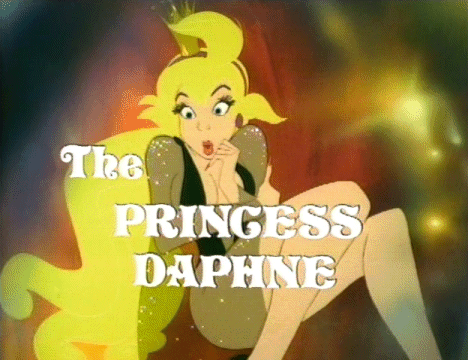
The beautiful but stereotypically blonde Princess Daphne
The original concept for the game came from Rick Dyer, president of Advanced Microcomputer Systems. Dyer was apparently a huge fan of William Crowther's text-based adventure game Colossal Cave Adventure, which has also been the inspiration for other computer games including the original MUD. He is reported to have also taken inspiration from the works of author J.R.R. Tolkien (primarily Lord of the Rings), and the 1982 animated film The Secret of Nimh, which was directed by Don Bluth and based on a children's novel written by Robert C. O'Brien. Dyer had already been working for some years on another LaserDisc-based game called The Secrets of the Lost Woods, which featured mostly static images for each scene, accompanied by a spoken narrative. He soon realised, however, that in order to capture the imaginations of a new generation of gamers, he would have to include animation. The central theme of Dragon's Lair was taken from a scene of the same name originally intended for inclusion in Secrets of the Lost Woods.
Dyer realised that the quality of the animation could well determine whether or not the game was a success. Consequently, Dyer and Jim Pearce (president of Cinematronics) sought out the services of Don Bluth. Prior to his work on The Secret of Nimh and other animated films, Bluth had worked as a Disney animator. He parted company with Disney in 1979 to set up his own animation studio, Don Bluth Productions. Bluth was presented with a set of storyboards created by the AMS game designers that detailed the various characters and scenarios for the game, but he and his team of animators (most if not all of whom were ex-Disney personnel) were given a relatively free hand. There were of course some constraints, as both the budget and the development timeframe were limited. The game reportedly took approximately seven months to develop, with the cost being estimated at a little over one million U.S. dollars. A company called Starcom was set up specifically for the venture, with Rick Dyer, Don Bluth Productions and Cinematronics each holding a one-third share in the new company.
The need to cut costs wherever possible meant that the animators did the voiceovers for the characters themselves, although the narration for the so-called attract sequence was done by a professional voice actor, Michael Rye. Princess Daphne's voice belonged to Vera Lanpher, who was in charge of the "Clean-up" department (the department responsible for producing "clean" versions of rough animation drawings). Dirk the Daring's voice was that of film editor Dan Molina. Not that there is an awful lot of dialogue - Dirk makes some fairly comical noises when confronted with various situations, but the only words he utters are "Uh, oh" (in one particular sequence, when the platform he is standing on begins to disappear) and "Wow!" when seeing Daphne for the first time. The character of Daphne was apparently based on pictures of a number of girls featured in Playboy magazine. Not that I would know anything about that particular publication . . . .
. . . anyway, the developers (including Don Bluth and his team of animators) were working under quite a bit of time pressure, and everyone was sworn to secrecy since "industrial espionage" was not uncommon in the gaming industry at the time. The game featured some original music, most of which could be heard in the attract mode. The synthesized soundtrack material was created by Chris Stone at EFX Systems in Burbank, California. EFX Systems were employed as outside contractors, and were not part of the development team as such. The final result was a game that included approximately twenty-two minutes of high-quality video animation and an original audio soundtrack. Both the video sequences and the soundtrack for the game were stored on a high-capacity LaserDisc, and the arcade cabinets incorporated LaserDisc players supplied by Pioneer Corporation (Pioneer is a multinational consumer electronics company based in Japan).
Like other arcade games of the period, the game's code ran on a Zilog Z80 microprocessor mounted on a proprietary motherboard. The game's hardware was housed in an upright cabinet fitted with a CRT colour monitor. An LED display mounted above the main screen could be used to display the player's score, the number of lives left, and the remaining credit. The controls consisted of an eight-way joystick which was used to control the movements of Dirk the Daring, and a single button which was used to control his use of the sword. And of course, there was the all-important LaserDisc player.
The inclusion of LaserDisc technology inevitably pushed up the cost of the cabinets. In fact, each arcade unit cost almost twice as much as a typical arcade unit for any other game of the time. Cinematronics justified the cost to potential customers by pointing out that the units could be used to accomodate future LaserDisc games (such as the companion game to Dragon's Lair, Space Ace) without requiring significant modification. Arcade owners were also somewhat dubious about the proposed cost-per-play for the game. At fifty cents, Dragon's Lair cost twice as much to play as most other arcade games of its day. In the early 1980s, most arcade games in the US were designed to relieve the player of a quarter in exchange for a single play (a quarter is a twenty-five cent coin). Nevertheless, the game proved to be hugely popular thanks largely to the sheer quality of its graphics, the likes of which had never before been seen in an arcade game. Long queues could be seen at any location in which a Dragon's Lair arcade game unit was installed.
Of course there were criticisms. As mentioned previously, the superb graphics were only possible thanks to the use of animated video sequences, which greatly restricted the extent to which the player could actually control events. A major complaint from seasoned gamers was that, once the correct sequence of control inputs had been learned for getting through each scene, the game presented no further challenges. There was also no particular incentive to achieve a high score (although points awarded were displayed above the screen), since once the game had been completed, that was it. There were no higher levels. Some players new to gaming, on the other hand, found the game difficult or impossible to play. The lack of visual cues (or any other clues for that matter) meant that inexperienced players were more likely to witness Dirk the Daring's untimely demise multiple times than to actually make progress in the game, let alone successfully complete it.
There were also technical annoyances for both players and operators. The LaserDisc hardware needed to switch between the various video sequences stored on the disc, depending on which commands the player had input via the joystick or button. This meant that there were often significant delays between scenes, during which nothing was happening on screen. For much the same reason, the LaserDisc players initially used for the game (which were originally designed to play LaserDisc movies in a linear fashion) were prone to failure after a relatively short period of use, typically a few hundred hours at best. This meant that operators frequently needed to replace the players. The situation was not helped by the fact that Pioneer could not produce the LaserDisc players anywhere near fast enough to meet demand, which in turn meant that Cinematronics could not keep up with the demand for game units. Despite the game's limitations, Dragon's Lair was at first immensely popular. It was hailed as a major breakthrough in gaming technology, and was seen by many as the saviour of the video gaming industry, which in 1983 was going through a recession.
Players of Dragon's Lair were meanwhile treated to stunning visuals never before seen in an arcade video game. The player must control the actions of Dirk the Daring as he encounters various dangers on his mission to seek out and rescue the beautiful Daphne. Control is by means of an eight-way joystick (used to control Dirk's movement left, right, up, down or in one of four diagonal directions) and a single button that controls Dirk's use of his sword. The player must essentially either move Dirk in the right direction, or trigger his use of the sword, at exactly the right time. Failure to make the right move at the right time results in Dirk's death, which is usually (though not always) depicted in graphic detail. Fortunately, the death sequences are just as entertaining as the sequences in which Dirk manages to escape his fate.

Dirk is prone to meeting a sticky end (in this case literally!)
The mechanics of the game are actually very simple. If you move the joystick in the right direction at the right time, and press the button at the right time, you move onto the next interactive scene and the next challenge. If not, you move on to the corresponding death scene. As mentioned above, the death scenes themselves can be quite entertaining. So much so, in fact, that players encountering a new scene have been known to deliberately allow Dirk to be killed just to see how he will meet his untimely end. In some cases, the exact details of Dirk's demise are not actually shown, and all we see is Dirk's sword or helmet hitting the floor. In every case, the player will be treated to a short scene in which Dirk drops into view from above with arms folded and a disgusted look on his face, turns into a skeleton, and crumbles to the floor.
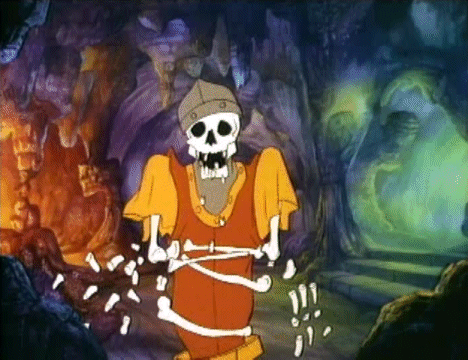
When Dirk dies, he turns into a skeleton and crumbles to the floor
Dirk will encounter all manner of dangers on his way through the castle, including amorphous creatures with multitudes of long green tentacles, giant spiders, snakes, blazing infernos, raging torrents of water, collapsing floors and ceilings, and all manner of bizarre creatures - basically all the worst parts of the Bible (OK, I admit it - I stole that line from Michael Bay's movie "Armageddon"). Anyway, to cut a long story short, there are some forty or so different scenarios in the game that Dirk will encounter before he can rescue Daphne, and in just about every one of them someone or something is trying to kill him. In some scenes, even apparently inanimate objects are not to be trusted. Dirk's facial expressions and utterances on encountering each new menace are highly entertaining, but the player must stay alert in order to escape the various perils.
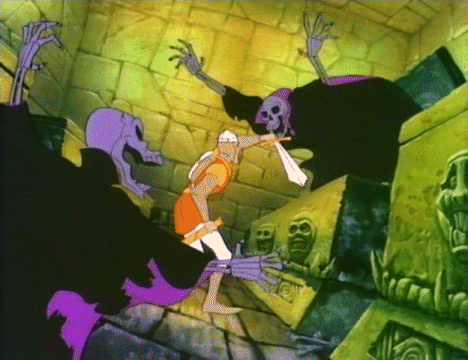
Dirk faces danger at every turn
The order in which the scenes appear can vary, depending on the specific version of the game being played. The only exceptions are the initial scene and the final showdown in the dragon's lair of the title, although for some reason the initial scene used for the North American version is different to that of the European version. In the European arcade version (which was licensed to Atari), the scenes appear in the order in which they are stored on the LaserDisc. The first scene (in the European version) is the drawbridge scene where Dirk first enters the castle, which also features in the "attract mode" sequence. It has been estimated that, if the player makes all the right moves, the game can actually be completed in approximately twelve minutes. This sounds reasonable considering that there are some twenty-two minutes of video material in total, and that a significant proportion of that video material depicts various death scenes (each scenario Dirk encounters within the game has its own unique death scene).
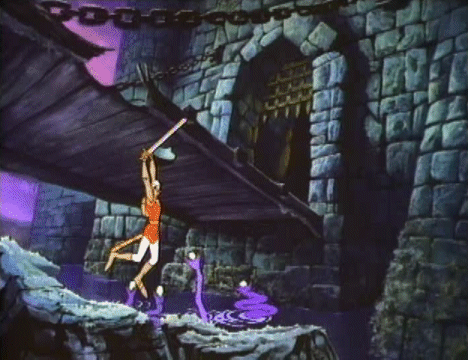
Dirk encounters danger before he even enters the castle
In the final scene of the game, Dirk has reached the dragon's lair and discovers that Princess Daphne is being held prisoner inside a magic bubble guarded by a rather large (though apparently sleeping) dragon. The key to the magic bubble is on a chain around the dragon's neck. Dirk is told about the key by Daphne, who also mentions that the only way to kill the dragon is by striking him with a magic sword (which just happens to be embedded in a jewel stone within the dragon's lair). If successful, he will be able to retrieve the key and free Daphne. Of course, he has to get past the dragon before he can get to the jewel stone with the sword in it. Needless to say, if our hero does manage to slay the dragon and free Daphne, she will be eternally grateful . . .
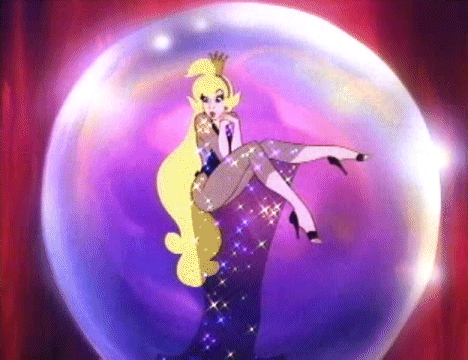
On reaching the dragon's lair, Dirk discovers Daphne trapped inside a magic bubble

Dirk must face a final showdown with the dragon to free Daphne

Love finally conquers all . . .
Dragon's Lair did indeed bring a much-needed boost to the video game industry in 1983, although ultimately it was to be a bright spot in an otherwise gloomy picture rather than the start of a recovery. It created a brief demand for LaserDisc games, which of course included the companion game Space Ace and a sequel, Dragon's Lair II: Time Warp. In the nine months or so following its release, Dragon's Lair would generate over thirty million dollars in sales of arcade game units, and an even higher figure in arcade revenues. As with other popular arcade games of the period, Dragon's Lair spawned a vast range of merchandise. This was no doubt something the developers had firmly in the back of their minds when they created the game's characters. Even the monsters in the game are designed to appeal to children, and are more humorous than scary. Typical products included lunch boxes, board games, children's clothing, posters, trading cards, stickers, action figures - the list is almost endless.
Like other arcade games of the era, Dragon's Lair has been featured in various forms of popular media. A Dragon's Lair arcade game unit could be seen in episodes of the US sitcom Silver Spoons which first aired on NBC's network in 1982. During the same period, the game was also featured in the arcade game related US game show Starcade. More recently, the character of Dirk the Daring was featured in an episode of the animated comedy sketch TV series Robot Chicken, and one of the scenes from the game was parodied in an episode of the animated adult sitcom Family Guy. An animated TV series based on the game, and produced by Ruby-Spears Productions, aired on the ABC network between September 1984 and April 1985 for a total of thirteen thirty-minute episodes. In the TV series, the dragon (who had no specific name in the actual game) was called "Singe", and Daphne was wearing a long pink dress. Well, it was a children's show!
Don Bluth and his fellow animator and business partner Gary Goldman have reportedly been planning a feature film based on the game for some years, and have everything in place including a completed script. The project has unfortunately been postponed indefinitely due to the fact that the necessary financial backing has so far not been forthcoming. At the time of writing however, a documentary film examining the phenomenon of Dragon's Lair is rumoured to be in the pipeline for release towards the end of 2013, thirty years after the game's original release, and will reportedly feature a number of interviews with legendary animator Don Bluth. Dragon's Lair certainly deserves its place in gaming history. Despite the fact that the popularity of LaserDisc games was somewhat short lived, this was the game that opened the eyes of gamers and game developers alike to new possibilities, particularly in terms of gaming graphics. Perhaps for that reason, Dragon's Lair is one of only three arcade games (the others being Pong and Pac-Man) on permanent display at the Smithsonian Institution in Washington D.C.
In the intervening years, Dragon's Lair and its sequels, remakes and spin-offs have been ported to just about every home computer and console platform. Most of the versions released for home computers and game consoles during the 1980s and early 1990s could not even remotely match the quality of the graphics seen in the original arcade version of the game due to the severe limitations imposed by available secondary storage media (typically audio cassettes, game cartridges, or floppy diskettes). Instead, they were usually platform-style adaptations that featured standard two-dimensional computer graphics. Some home computer versions managed to get close to the gameplay and graphic quality of the original by using a combination of video compression techniques and multiple floppy discs. Even so, a number of scenes from the original game had to be omitted in order to reduce the amount of storage required. The advent of high-capacity optical media during the 1990s, together with the availability of affordable optical drives for home computers and consoles, was a key factor in improving the graphical quality of games produced for these platforms.
The rights to the original LaserDisc games Dragon's Lair, its companion game Space Ace, and the sequel Dragon's Lair II: Time Warp are currently owned by Canadian software publishing company Digital Leisure Inc. Since 1997, Digital Leisure have published versions of these games for various platforms, including both IBM PC compatible and Macintosh personal computers, the Sony PlayStation (PS2, PS3 and PSP), the Nintendo Wii and hand-held consoles (DSi, DS and 3DS), Microsoft's Xbox consoles, and more recently mobile devices such as smartphones and tablet computers. There are even releases that run on standard DVD and Blu-ray players, in which the game is controlled using the keypad on the player's remote control.
If you want to enjoy an authentic arcade game experience on your computer, Dragon's Lair, in its original arcade format, can be played using an arcade emulator such as DAPHNE, which can be downloaded free of charge from the DAPHNE website (http://www.daphne-emu.com). The emulator software allows you to play Dragon's Lair (and many other classic arcade games), and will automatically download the required files from the Internet. The only drawback is that (at least with the most recent version of DAPHNE) you are required to insert a genuine Digital Leisure DVD-ROM disc into your DVD drive in order to prove that you own a legitimate version of the game before you can actually play it. There may of course be a work-around available, but we are unable to determine whether this is the case at the current time.